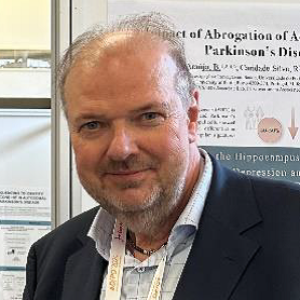Title : Golexanolone, a GABAA receptor-modulating steroid antagonist, improves microglia activation and tyrosine hydroxylase levels in substantia nigra, dopamine in striatum and several motor and non-motor alterations in 6-OHDA rats
Abstract:
There are no drugs available for Parkinson’s disease (PD) that alter progression of disease. Current symptomatic treatments provide imperfect relief and have side effects. Enhanced GABAergic neurotransmission contributes to PD pathogenesis. In animal models, GABA levels are increased in substantia nigra (SN), leading to reduced expression of tyrosine hydroxylase (TH) in neurons which contributes to the behavioural deficits.
Background: We have recently shown that treatment with golexanolone, a well-tolerated GABAA receptor-modulating steroid antagonist in clinical development, improves some motor and non-motor deficits in 6-OHDA rats (1). Treatment starting 4 weeks after surgery (6-OHDA injection) improved motor coordination and locomotor gait alterations and non-motor deficits including fatigue, anxiety, anhedonia and short-term memory. Moreover, golexanolone treatment did not induce dyskinesia, as L-DOPA does, and improved glial activation and loss of TH in striatum.
Aims: The aims were to analyse if golexanolone improves microglia activation and TH levels in SN and dopamine levels in striatum, which are main steps in the mechanisms leading to neurological impairments in PD. We also analysed if beginning treatment earlier (one week after surgery) affords more beneficial effects on neurological impairment than starting four weeks after surgery.
Methods: We used unilateral 6-OHDA rats. Golexanolone treatment (50 mg/kg, daily, intragastric) started one week after surgery. A group of rats was sacrificed at 3 weeks for mechanistic analyses. Another group performed behavioural tests at 6-8 weeks. Motor symptoms were assessed in the CatWalk. We also analysed fatigue (treadmill), and short-term memory (Y maze). TH in SN and dopamine levels in striatum were analysed by immunofluorescence and microglia activation in SN was analysed for the content of glutaminase by double immunofluorescence (Iba1 staining).
Results: Glutaminase levels inside microglia are increased in SN of 6-OHDA rats, indicating microglia activation. Golexanolone completely reversed this effect, indicating reversal of microglia activation. TH levels are reduced in SN of 6-OHDA rats. Golexanolone significantly increased TH levels. Reduction of TH in SN in 6-OHDA rats is associated with reduced dopamine levels in striatum. Golexanolone treatment completely reversed this decrease, returning dopamine to normal levels. Starting treatment 1 week after surgery improves short-term memory and the following parameters in the Catwalk (7 weeks after surgery): regularity index, initial dual stance and duty cycle. This treatment also improves several parameters which were not improved when treatment started 4 weeks after surgery: terminal dual stance, step cycle, print positions, swing and afforded more sustained improvement of fatigue.
Conclusion: Golexanolone is a novel oral small molecule in clinical development for CNS disorders due to neuroinflammation and enhanced GABAergic neurotransmission. Golexanolone treatment improves main steps of the mechanisms leading to behavioural impairment in PD: microglia activation and tyrosine hydroxylase in SN and dopamine levels in striatum. Golexanolone may be useful to improve different symptoms that affect the patients’ quality of life: Anxiety, depression, fatigue, motor coordination and locomotor gait, and some cognitive alterations. Early onset of treatment generates sustained treatment effects indicating a potential for reduced symptomatic progression.
Audience Takeaway Notes:
- One of the main advantages would be the potential to address non-motor symptoms of PD, which are often not adequately managed by dopaminergic therapies like MAO-B inhibitors and significantly impact the quality of life in PD patients.
- Targeting GABAA could be used in combination with dopaminergic therapies, including MAO-B inhibitors, to provide a more comprehensive treatment approach that addresses both motor and non-motor symptoms.
- GABAA represents a novel approach by modulating GABAergic neurotransmission rather than directly influencing dopaminergic systems. This may be beneficial in cases where motor symptoms are well-managed with other therapies, but non-motor symptoms persist.
- MAO-B inhibitors, while beneficial, can sometimes lead to side effects related to increased dopamine levels, such as dyskinesia or impulse control disorders. Golexanolone does not induce LID, potentially avoiding these side effects while still offering therapeutic benefits.




